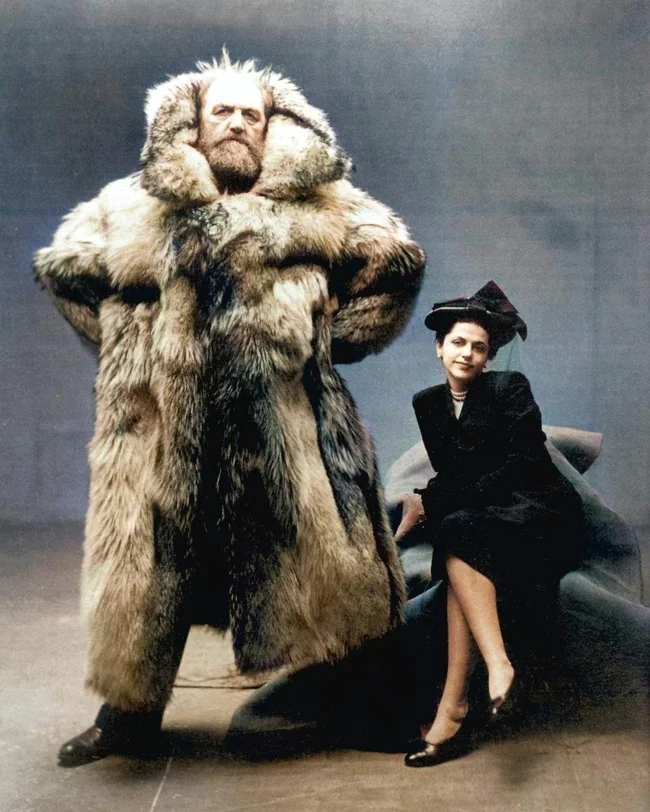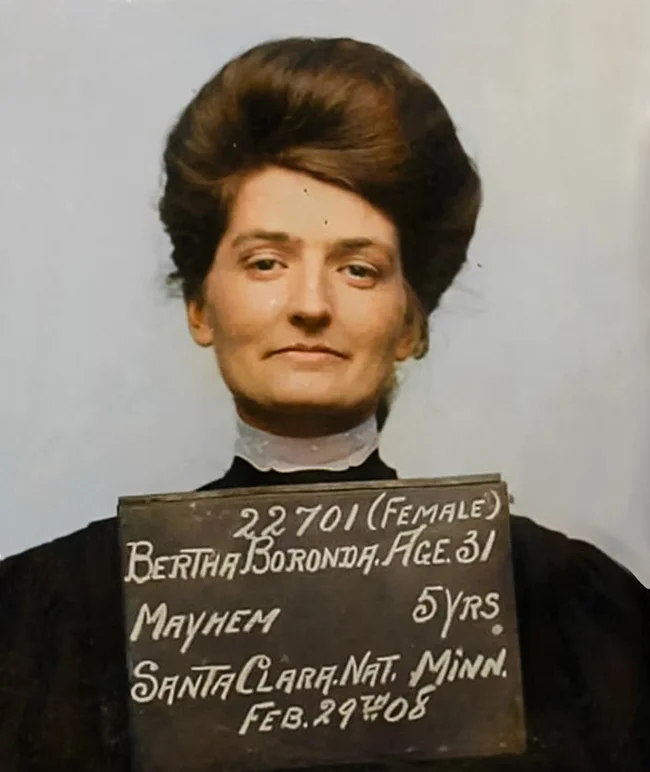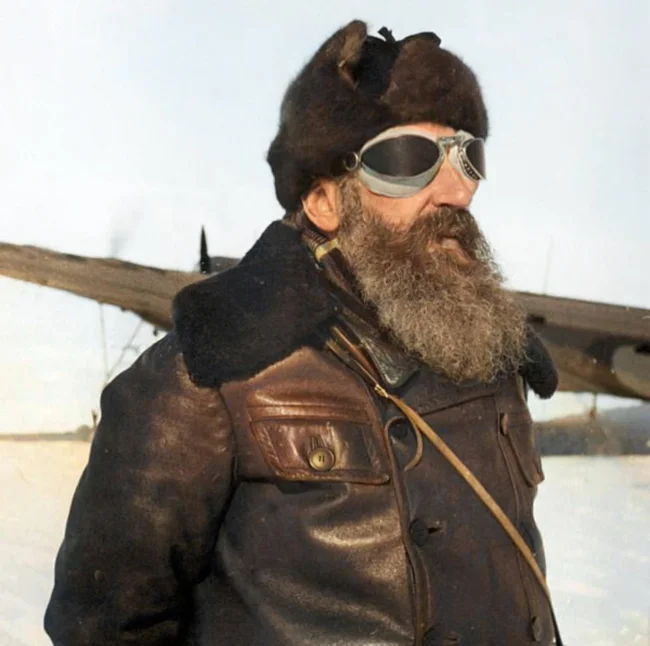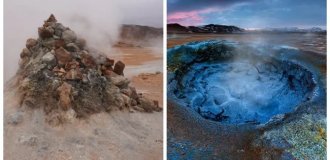Several interesting stories from the lives of unusual personalities (6 photos)
Stories of extraordinary and sometimes eccentric people whose lives fell on the 19th and 20th centuries. 
Andre the Giant and professional boxer Bobby Chacon, 1979.
224 centimeters tall and 236 kilograms in weight - that was the French wrestler Andre the Giant. Despite all his apparent strength, he was a kind person whose life ended too early.
The reason for such unique parameters is a disease - gigantism, caused by excess growth hormone. 
Andre was born in France to Bulgarian-Polish immigrants. As he grew older, his unusual athletic abilities began to attract attention, first in his native country, then in Europe, and then around the world.
At the age of 18, Andre Rene Roussimoff moved to Paris, where he began wrestling. In the early 1970s, he had already become a star and received his legendary nickname - Andre the Giant, which accompanied him until his last days.
In 1974, he was listed in the Guinness Book of Records as the highest paid wrestler in history. And when his career reached its peak, he became the first member of the WWF Hall of Fame.
Naturally, such a "colossus" could not go unnoticed by filmmakers. Andre starred in many films, where he met Hollywood celebrities.
Despite his frightening appearance, Andre was a kind, gentle and generous person. His friends unanimously emphasized his positive qualities.
It seemed that the future promised him great achievements and a long happy life. But fate decreed otherwise. The athlete suffered from acromegaly - a disease that led to an increase in the skull, hands, feet and other parts of the body. Over time, this disease increasingly affected his health.
Andre the Giant passed away on January 27, 1993, aged just 47. As for his inheritance, his vast fortune was left to his daughter Robin Christensen.
Elspeth Beard, the first female motorcyclist to circumnavigate the world, 1982
Elspeth Beard made history as the first British woman to circumnavigate the globe on a motorcycle. Her three-year journey covered 55,000 km, passing through many countries and continents. 
Elspeth had a passion for motorcycles from a young age, starting to ride at the age of 16. During her school years, she began saving up to buy a used BMW R 60/6 motorcycle, which she used to take on her first long-distance journey in 1982.
Her famous round-the-world journey began in New York, where she arrived by boat. From there, her route took her through Canada, Mexico and Los Angeles. Then, having crossed over to Australia by ship, she spent 11 months in Sydney, working as an architect to save up for the continuation of the journey. However, an accident with a concussion almost cut her adventure short, but a local family helped her recover from the incident.
The further journey took her through Asia: Malaysia, Thailand, India, Nepal, Pakistan, Iran, Turkey and European countries. The journey was full of dangers and unexpected obstacles: In Singapore, her documents were stolen, and it took her six weeks to get them back.
In Thailand, the second accident was the result of a collision with a dog, but again, the help of local residents saved her from serious consequences.
In India, due to the closure of the border with Pakistan after the assassination of Indira Gandhi, she had to forge documents to safely pass through control.
In Turkey, she contracted hepatitis and spent six weeks undergoing treatment. During the events in Yugoslavia, she had to overcome the so-called "Death Road", where she again risked her life, but continued on her way.
Upon returning to London in 1987, Elspeth expected attention and recognition, but her achievement went almost unnoticed. She simply put her motorcycle in the garage and returned to everyday life.
Life after the trip
Later, Elspeth bought a disused water tower in Munstead (Godalming), built in 1898, and completely restored it over five years. For this work, she was awarded the prestigious Royal Institute of British Architects award in 1994. In 2019, her unique home was featured in a documentary series.
In 2017, Elspeth released an autobiography in which she described in detail her first trip around the world. According to her, this adventure not only strengthened her character, but also completely changed her worldview, teaching her not to give up in the face of difficulties.
Repeat trip
In 2002, Elspeth decided to repeat her greatest achievement by organizing a group trip around the world on motorcycles. This time she was accompanied by 23 people, which made her second expedition even more ambitious and memorable.
She is now 65 years old, and she still continues to ride her "iron horse".
Danish traveler and explorer Peter Freuchen with his wife Dagmar, 1947 
Peter Freuchen is an outstanding Danish polar explorer, explorer and adventurer, whose life has become a shining example of human resilience and extraordinary achievements. Born in 1886, he left the University of Copenhagen to travel to the Arctic with Knud Rasmussen. In Greenland, he not only studied the culture of the Inuit, but also founded the trading post "Thule", which helped locals exchange their products for necessary goods.
His career paths were varied: from publishing a magazine for housewives to participating in film production and working on scripts for adventure films. During World War II, Freuchen actively fought against the Nazi occupation of Denmark, for which he was arrested by the Gestapo. He managed to escape, after which he emigrated to the United States, where he continued to write books, act in films and even became a finalist on a popular TV show.
Peter Freuchen died on September 2, 1957, at Elmendorf Air Force Base in Anchorage, preparing for a new journey. His ashes were scattered in Greenland, a place that will forever remain his second home. This man truly deserves the title of one of the greatest adventurers of the 20th century, combining scientific research, heroism and unconventional solutions in the most difficult situations.
I advise you to read about his expeditions in more detail, his biography and the stories of their expeditions are worth attention!
Criminal Bertha Boronda, 1908
Bertha Boronda (1877 - 1950) was an American woman whose life was marked by a dramatic event in 1907, when she committed an act of violence against her husband, using a dangerous razor (deprived him of dignity). This case became resonant, and Bertha was found guilty of causing grievous bodily harm and sent to San Quentin prison. 
On the night of May 30-31, 1907, Bertha attacked her husband Frank Boronda, a captain of the San Jose Fire Department. After visiting the theater, the couple went to bed, but while he was sleeping, she decided to take a cruel step and cut off his genitals. Frank was able to get to the fire station, where he received first aid, after which he was taken to the hospital for further treatment.
After the crime, Bertha left the scene of the crime, dressed in men's clothing and used a bicycle to escape. She was detained only a day later.
At the trial, Bertha showed no remorse. She explained her actions as revenge for her husband's infidelity, who she believed was planning to leave her and flee to Mexico.
Bertha's trial began on January 13, 1908, before Judge James R. Welch. The prosecutor presented a theory of premeditated attack motivated by jealousy. Bertha, in turn, claimed that she had seen letters from other women to her husband twice and began to suspect him of infidelity. She admitted the attack, but did not express remorse.
The jury deliberated for two hours, after which it was unanimously found her guilty. The judge sentenced her to five years in prison, but Bertha was paroled two years later, on December 20, 1909, due to good behavior.
After the incident, their paths diverged: Frank survived the trauma and even entered into a third marriage in 1925. He continued to work in the fire service, but was soon demoted and forced to resign. Frank died in 1940 at the age of 76.
Bertha remarried in 1921, but this marriage also ended in divorce. In the following years, she worked as a maid, laundress and waitress in various cities in California.
The leader of the First High-Latitude Air Expedition to the North Pole, Otto Schmidt, 1937
Otto Yulievich Schmidt was an outstanding Soviet scientist, polar explorer, mathematician and organizer of Arctic research. His life was dedicated to the study of the North, the development of new technologies for the exploration of the Arctic and the creation of infrastructure in hard-to-reach regions. He became one of the key figures in the history of the development of the Soviet Arctic. 
Some interesting facts about Otto Schmidt
Even in his childhood, Otto Yulievich dreamed of great travels and scientific discoveries. When asked about his desired profession, he unexpectedly answered that he would like to become the head of the Sahara Desert in order to provide it with water. This early dream anticipated his future achievements in the study of harsh natural conditions.
In his youth, Otto fell ill with tuberculosis, and doctors advised him to go to Austria for treatment. There, to improve his health, he began mountaineering, accumulating experience that later proved invaluable in his Arctic expeditions.
Otto Schmidt played a key role in the creation of the Great Soviet Encyclopedia (1924-1942). These books were in almost every home: they were used by schoolchildren, students and scientists. It is also believed that the term "graduate student" in the educational system was introduced thanks to Schmidt.
In 1937, under the leadership of Otto Yulievich, a unique expedition was organized, which equipped the first scientific drifting station "North Pole-1" right in the center of the Arctic Ocean. This project became innovative in the study of the Arctic.
Otto Schmidt left his mark on the history of the world map: an island in the Kara Sea, a peninsula in the north of Novaya Zemlya, a cape on the Chukchi coast, a pass and a peak in the Pamirs were named in his honor. In 1995, the Russian Academy of Sciences established the O. Yu. Schmidt Prize for outstanding work in the development of the Arctic.
At different periods of the 20th century (1935, 1966, 1980 and 2001), postage stamps with his portrait were issued in his honor.
Otto Schmidt remains an important figure in history whose life was dedicated to exploration and science.























